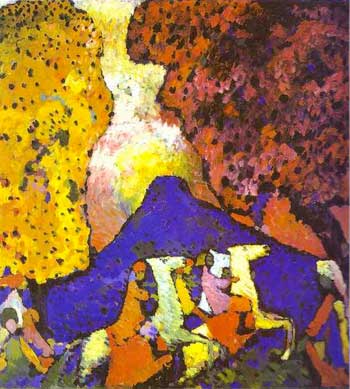
Saving the World with Art
Vasily Kandinsky’s Munich years at the Guggenheim
By Maureen Mullarkey
VASILY KANDINSKY (1866-1944).WAS THE BECKONING PRIEST of an aestheticized, secular spirituality that has become the fallback position for agnostics with a yen for transcendence. This display from the Guggenheim’s permanent collection showcases Kandinsky’s early work produced in Munich from 1903 to 1911, the year he published “Concerning the Spiritual in Art”.
 |
| Blue Mountain, Vasily Kandinsky |
Kandinsky came to painting late. Born into a wealthy, aristocratic Russian family, he began his studies in law at the University of Moscow. He was 30 before he rejected a law professorship in Estonia and went to study art in Munich. Second only to Paris as a training center in the arts, Munich was also, as historians of the era describe it, a state of mind.
A destination for radical intellectuals from outside Bavaria and beyond Germany, it was home to a circle of young Russian artists for whom the sugarplums of revolutionary thought were as much a part of München life as Oktoberfest. Joined by Kandinsky in 1896, these painters would soon fertilize German expressionist painting. That enrichment culminated in the 1912 Blaue Reiter exhibition.
With the Guggenheim under renovation, its Tannhauser wing has room for only a sampling of work from those Munich years: woodcuts, linocuts, völkisch paintings on glass, small cityscapes, and four paintings from Kandinsky’s Blaue Reiter period. It is just enough to cast light on the trajectory of his later work.
Sparsely colored woodcuts, with their sinuous Jugendstil influence, testify to the strength of his linear imagination. “Lady with a Fan” (1903) is a marvel of suggestive economy. A crinolined figure sits in the foreground; only the patterning of her dress distinguishes her from the blackened landscape. Her elaborate coiffure is unseen but indicated by the edge of a bonnet set unnaturally high against the background. A line that reads easily as a bonnet string doubles as a moonlit path through the middle ground.
Two tiny glass paintings provide a peek into the artist’s abiding interest in the folk arts of Old Russia. Fascination with ethnography and the premodern was a phenomenon of the age that crossed national boundaries. While William Butler Yeats, Kandinsky’s contemporary, collected Irish folk tales, the artist explored Lapp designs and the decorative patterns of shaman costumes.
Three of the Blaue Reiter paintings, linked by color and vigor to Franz Marc, are stunners. Kandinsky’s fame rests largely on the later abstractions but his early Fauvist palette produced some of his loveliest and most seductive works.
“Blue Mountain” (1908-9) is a vigorous composition marked by lively brushwork and dynamic color interaction between broad areas of variegated yellows and reds that rise above an ultramarine mountain. Advancing across the bottom of the canvas, are schematic riders on white horses, a signature emblem of the Four Horsemen from the Book of Revelation. Although a sense of impending apocalypse suffused the decade before World War I, the exuberant beauty of the work conveys only the pleasure of painting.
“Pastorale” (1911) is the fourth and most abstract of the Blaue Reiter group. A bleached efflorescence of pastels punctuated by a single spidery burst of darker color, it is an instructive work. Its formal driftlessness illustrates the risks of taking dictation from one’s own “inner necessity”, a flimsy magisterium for what Kandinsky called the “Era of the Great Spiritual”. Viewed in context with the clarity and expressive precision of his graphic work, “Pastorale” indicates how much Kandinsky’s gifts required the force of line. Once he abandoned even loose reference to visual reality, he needed another ordering principle. That he sought it in analogies to music is no surprise. He was an accomplished musician himself, as were his parents, and he had already tried his hand at compositing.
Attempts to correlate sound to color were in the air and Kandinsky was very much a man of his time and place. Goethe, in 1910, wrote that colors should be used according to their emotional, indeed musical, associations. Before that, Ludwig Tieck (d. 1853), a Romantic poet and influence on Wagner, famously wrote: “For every lovely painting, there is without doubt a complimentary piece of music and the two together have but one soul.”
Music, and its structural affinities with mathematics, offered Kandinsky a rationale for containing color within the contours of a canon of his own devising. A variable, free verse geometry, it was a fertile tour de force that allowed the artist to put his commitment to abstraction through a series of graphic paces. And it provided a vehicle for synthesizing existing efforts toward an objectless art that were in currency at the time.
Kandinsky, like many 19th century Russians attracted to European fashions in spiritualism. transferred the mystical strain of a Russian Orthodox upbringing to art itself. Theosophy (confected by Helena Blatavsky, another Russian] offered a profane bridge between the two. Marianna Verefkina, whose Munich salon Kandinsky frequented, anticipated his cosmic ambitions by pronouncing: "Art, thought, love — out of these I will make a religion, a cult. I am its temple, its priest, its God.… The artist is one who has made beauty a God and seeks forms to make this God visible.”
Orthodoxy’s theology of beauty developed over centuries. Its color symbolism, canon of ethereal a capella choral music and emphasis on a two dimensional iconographic surface — considered more accessible to mystery than 3-dimensional realism — lurk in the wings of Kandinsky’s grand design for creating the paradox of a de-sacralized sacred art.
“Beauty will save the world,” declared Dostoevsky (d. 1881). Kandinsky agreed. But the Beauty appealed to by the creator of Alyosha Karamazov is more than the product of a painter’s hand.




“Kandinsky: An Ongoing Exhibition” at the Guggenheim Museum (1071 5th Avenue at 89th Street, 212-423-3500).
This review appeared first in The New York Sun August 14, 2008.
Copyright 2008, Maureen Mullarkey







